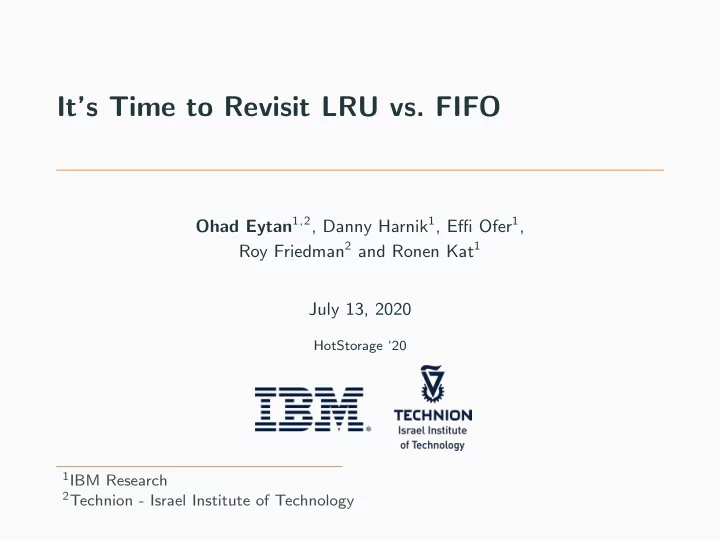

It’s Time to Revisit LRU vs. FIFO Ohad Eytan 1,2 , Danny Harnik 1 , Effi Ofer 1 , Roy Friedman 2 and Ronen Kat 1 July 13, 2020 HotStorage ‘20 1 IBM Research 2 Technion - Israel Institute of Technology
The Essence of Caching • A fast but relatively small storage location • Temporarily store items from the “real storage” 1
The Essence of Caching Miss • A fast but relatively small Hit storage location • Temporarily store items from the “real storage” • Improves performance if hit-ratio is high 1
LRU & FIFO Least Recently Used and First In First Out Policies • The core component of the cache is the admission/eviction policy • FIFO - holds the items in a queue: ⋆ On a miss: admit new item to the queue and evict the next in line ⋆ On a hit: no update is needed • LRU - holds the items in a list: ⋆ On a miss: add new item to list tail and evict item from list head ⋆ On a hit: move item to the list tail • Both are simple & efficient 2
Traditionally: LRU Considered Better 3
Traditionally: LRU Considered Better 1990 3
Traditionally: LRU Considered Better 1990 1991 3
Traditionally: LRU Considered Better 1990 1991 1992 3
Traditionally: LRU Considered Better 1990 1991 1992 1999 3
Traditionally: LRU Considered Better 1990 1991 1992 1999 Does it still hold? 3
New World • New workloads: ⋆ Old world: file and block storage ⋆ Today: videos, social networks, big data, machine/deep learning ◦ In particular we are interested in object storage (e.g. Amazon S3, IBM COS) 4
New World • New workloads: ⋆ Old world: file and block storage ⋆ Today: videos, social networks, big data, machine/deep learning ◦ In particular we are interested in object storage (e.g. Amazon S3, IBM COS) • New scale of data: ⋆ Orders of magnitude higher ⋆ Emergence of cloud storage and persistent storage caches ⋆ Cache metadata can potentially surpass memory 4
Motivation - Cloud Object Storage • Data resides on an “infinite scale” remote hub • Local “limited scale” on a local spoke to improve latency ⋆ Possibly 100s of TBs in size ⋆ Some of the metadata will have to reside on persistent storage 5
Our Cost Model • Metadata accesses: 6
Our Cost Model • Metadata accesses: • Hit rate paints only part of the picture 6
Our Cost Model • Metadata accesses: • Hit rate paints only part of the picture • We formulated a cost model that accounts also for persistent storage latency: data + metadata data � �� � � �� � Cost LRU = HR LRU · ( ℓ Cache + ℓ CacheMD ) + (1 − HR LRU ) · ℓ Remote data data � �� � � �� � Cost FIFO = HR FIFO · ℓ Cache + (1 − HR FIFO ) · ℓ Remote 6
IBM Cloud Object Storage Traces • We collected 99 traces from IBM public Cloud Object Storage service • Over 850 millions accesses to over 150TB of data 7
IBM Cloud Object Storage Traces • We collected 99 traces from IBM public Cloud Object Storage service • Over 850 millions accesses to over 150TB of data • Some observations about the IBM traces: Great variance in object sizes Great variance in access patterns 7
IBM Cloud Object Storage Traces • We collected 99 traces from IBM public Cloud Object Storage service • Over 850 millions accesses to over 150TB of data • Some observations about the IBM traces: Great variance in object sizes Great variance in access patterns • We are publishing the traces and encourage you to use it 7
Evaluation • We evaluated FIFO vs. LRU using 4 sets of traces: Group Traces Accesses Objects Objects Size Name # Millions Millions Gigabytes MSR 3 68 24 905 SYSTOR 3 235 154 4,538 TPCC 8 94 76 636 IBM COS 99 858 149 161,869 • Tested different cache sizes (as percentage of trace object size) • Simulated different ratios between latency of cache and remote 8
Results Pure Hit Rate: 9
Results Cost Winners: ℓ Cache = 1 , ℓ Remote = 50 10
Results Cost Heatmap: ℓ Cache = 1 , ℓ Remote = 50 Cache Size = 30% 11
Conclusions & Discussion • It’s no longer clear that LRU is a better choice than FIFO • Hit rate doesn’t tell the entire story • Our IBM COS traces can provide new insights and opportunities for research 12
Thank You! Ohad Eytan Effi Ofer ohadey@cs.technion.ac.il effio@il.ibm.com Danny Harnik dannyh@il.ibm.com Roy Friedman Ronen Kat roy@cs.technion.ac.il ronenkat@il.ibm.com
Recommend
More recommend